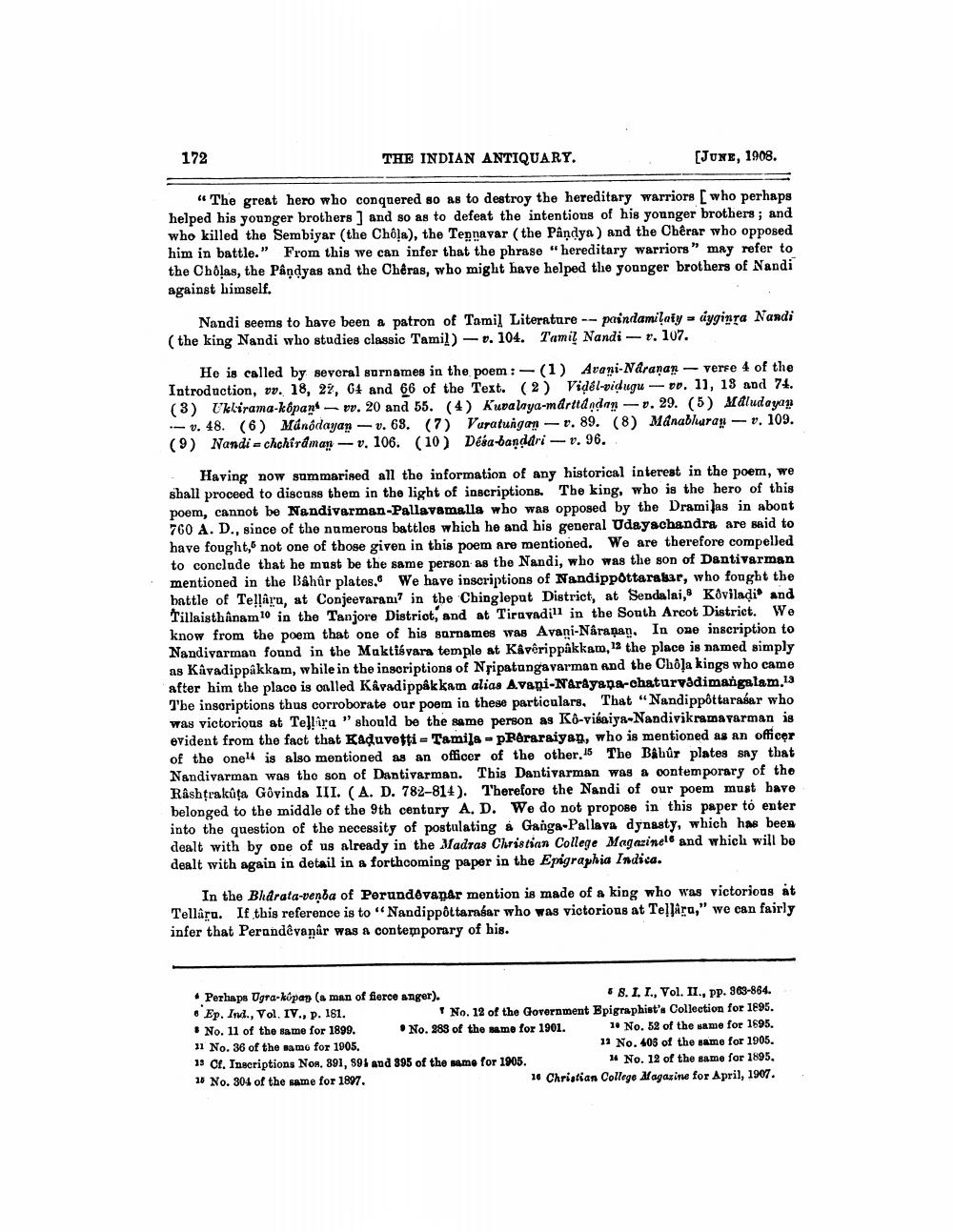________________
172
THE INDIAN ANTIQUARY.
[JUNE, 1908.
“The great hero who conquered so as to destroy the hereditary warriors [ who perhaps helped his younger brothers ] and so as to defeat the intentions of his younger brothers; and who killed the Sembiyar (the Chola), the Tepnavar (the Pandya ) and the Chêrar who opposed him in battle." From this we can infer that the phrase "hereditary warriors" may refer to the Cholas, the Pândyas and the Chêras, who might have helped the younger brothers of Nandi against himself.
Nandi seems to have been a patron of Tamil Literature -- paindamilaiyáyginra Nandi (the king Nandi who studies classic Tamil) - 0. 104. Tamil Nandi - r. 107.
He is called by several surnames in the poem :-(1) Avani-Naranan - verre 4 of the Introduction, vv. 18, 22, 64 and 66 of the Text. (2) Vidél-pidugu - ov. 11, 13 and 74. (3) Uklirama-kopant - pv. 20 and 55. (4) Kuvalaya-marttándan - D. 29. (5) Naludayap .- v. 48. (6) Mánódayan - v. 69. (7) Vuratungan - . 89. (8) Manabluran --- v. 109. (9) Nandi echchiraman - v. 106. (10) Désa-bandari - v. 96.
Having now summarised all the information of any historical interest in the poem, we shall proceed to discuss them in the light of inscriptions. The king, who is the hero of this poem, cannot be Nandivarman-Pallavamalla who was opposed by the Dramilas in about 760 A. D., since of the numerous battlos which he and his general Udayachandra are said to have fought, not one of those given in this poem are mentioned. We are therefore compelled to conclude that he must be the same person as the Nandi, who was the son of Dentivarman mentioned in the Bahûr plates. We have inscriptions of Nandippóttarakar, who fought the battle of Tellaru, at Conjeevaran? in the Chinglepat District, at Sendalai, Koviladi and Tillaisthanam 10 in the Tanjore Distriot, and at Tiravadill in the Sonth Arcot District. We know from the poem that one of his surnames was Avani-Narasan. In one inscription to Nandivarman found in the Maktiśvara temple at Kaverippakkam, 12 the place is named simply as Kavadippakkam, while in the inscriptions of Nripatangavarman and the Chôļa kings who came after him the place is onlled Káradippâk kam alias Avapi-Narayana-chaturvadimangalam.13 The insoriptions thus corroborate our poem in these particulars, That “Nandippôttarasar who was victorious at Tellira " should be the same person as Kô-visaiya-Nandivikramavarman is evident from the fact that Kaduvetti - Tamila - pPeraraiyan, who is mentioned as an officer of the one is also mentioned as an officer of the other.15 The Bahûr plates say that Nandivarman was the son of Dantivarman. This Dantivarman was a contemporary of the Râshtrakůţa Govinda III. (A. D. 782-814). Therefore the Nandi of our poem must have belonged to the middle of the 9th century A. D. We do not propose in this paper to enter into the question of the necessity of postulating á Ganga-Pallava dynasty, which has been dealt with by one of us already in the Madras Christian College Magazinelo and which will be dealt with again in detail in a forthcoming paper in the Epigraphia Indica.
In the Bharata-venda of Perundovanar mention is made of a king who was victorious at Tellûra. If this reference is to "Nandippôttaraśar who was victorious at Tellara," we can fairly infer that Perandêvanêr was a contemporary of his.
• Perhaps Ugra-kúpan (a man of fierce anger).
68.1.1., Vol. II., PP. 963-864. • Ep. Ind., Vol. IV., P. 181.
No. 12 of the Government Bpigraphist's Collection for 1895. • No. 11 of the same for 1899. No. 283 of the same for 1901. 10 No. 52 of the same for 1895. 11 No. 36 of the same for 1005.
11 No. 40% of the same for 1905. 13 Cl. Inscriptions Non, 891, 891 and 895 of the same for 1905.
No. 12 of the same for 1895, 16 No. 304 of the same for 1897.
16 Christian College Magazine for April, 1907.




